Curved Text Detection
Curved text detection is the process of identifying and localizing text that is curved or non-linear in images.
Papers and Code
Text in the Dark: Extremely Low-Light Text Image Enhancement
Apr 22, 2024



Extremely low-light text images are common in natural scenes, making scene text detection and recognition challenging. One solution is to enhance these images using low-light image enhancement methods before text extraction. However, previous methods often do not try to particularly address the significance of low-level features, which are crucial for optimal performance on downstream scene text tasks. Further research is also hindered by the lack of extremely low-light text datasets. To address these limitations, we propose a novel encoder-decoder framework with an edge-aware attention module to focus on scene text regions during enhancement. Our proposed method uses novel text detection and edge reconstruction losses to emphasize low-level scene text features, leading to successful text extraction. Additionally, we present a Supervised Deep Curve Estimation (Supervised-DCE) model to synthesize extremely low-light images based on publicly available scene text datasets such as ICDAR15 (IC15). We also labeled texts in the extremely low-light See In the Dark (SID) and ordinary LOw-Light (LOL) datasets to allow for objective assessment of extremely low-light image enhancement through scene text tasks. Extensive experiments show that our model outperforms state-of-the-art methods in terms of both image quality and scene text metrics on the widely-used LOL, SID, and synthetic IC15 datasets. Code and dataset will be released publicly at https://github.com/chunchet-ng/Text-in-the-Dark.
End-to-End User-Defined Keyword Spotting using Shifted Delta Coefficients
May 23, 2024Identifying user-defined keywords is crucial for personalizing interactions with smart devices. Previous approaches of user-defined keyword spotting (UDKWS) have relied on short-term spectral features such as mel frequency cepstral coefficients (MFCC) to detect the spoken keyword. However, these features may face challenges in accurately identifying closely related pronunciation of audio-text pairs, due to their limited capability in capturing the temporal dynamics of the speech signal. To address this challenge, we propose to use shifted delta coefficients (SDC) which help in capturing pronunciation variability (transition between connecting phonemes) by incorporating long-term temporal information. The performance of the SDC feature is compared with various baseline features across four different datasets using a cross-attention based end-to-end system. Additionally, various configurations of SDC are explored to find the suitable temporal context for the UDKWS task. The experimental results reveal that the SDC feature outperforms the MFCC baseline feature, exhibiting an improvement of 8.32% in area under the curve (AUC) and 8.69% in terms of equal error rate (EER) on the challenging Libriphrase-hard dataset. Moreover, the proposed approach demonstrated superior performance when compared to state-of-the-art UDKWS techniques.
Advanced Knowledge Extraction of Physical Design Drawings, Translation and conversion to CAD formats using Deep Learning
Mar 17, 2024The maintenance, archiving and usage of the design drawings is cumbersome in physical form in different industries for longer period. It is hard to extract information by simple scanning of drawing sheets. Converting them to their digital formats such as Computer-Aided Design (CAD), with needed knowledge extraction can solve this problem. The conversion of these machine drawings to its digital form is a crucial challenge which requires advanced techniques. This research proposes an innovative methodology utilizing Deep Learning methods. The approach employs object detection model, such as Yolov7, Faster R-CNN, to detect physical drawing objects present in the images followed by, edge detection algorithms such as canny filter to extract and refine the identified lines from the drawing region and curve detection techniques to detect circle. Also ornaments (complex shapes) within the drawings are extracted. To ensure comprehensive conversion, an Optical Character Recognition (OCR) tool is integrated to identify and extract the text elements from the drawings. The extracted data which includes the lines, shapes and text is consolidated and stored in a structured comma separated values(.csv) file format. The accuracy and the efficiency of conversion is evaluated. Through this, conversion can be automated to help organizations enhance their productivity, facilitate seamless collaborations and preserve valuable design information in a digital format easily accessible. Overall, this study contributes to the advancement of CAD conversions, providing accurate results from the translating process. Future research can focus on handling diverse drawing types, enhanced accuracy in shape and line detection and extraction.
Enhancing Scene Text Detectors with Realistic Text Image Synthesis Using Diffusion Models
Nov 28, 2023



Scene text detection techniques have garnered significant attention due to their wide-ranging applications. However, existing methods have a high demand for training data, and obtaining accurate human annotations is labor-intensive and time-consuming. As a solution, researchers have widely adopted synthetic text images as a complementary resource to real text images during pre-training. Yet there is still room for synthetic datasets to enhance the performance of scene text detectors. We contend that one main limitation of existing generation methods is the insufficient integration of foreground text with the background. To alleviate this problem, we present the Diffusion Model based Text Generator (DiffText), a pipeline that utilizes the diffusion model to seamlessly blend foreground text regions with the background's intrinsic features. Additionally, we propose two strategies to generate visually coherent text with fewer spelling errors. With fewer text instances, our produced text images consistently surpass other synthetic data in aiding text detectors. Extensive experiments on detecting horizontal, rotated, curved, and line-level texts demonstrate the effectiveness of DiffText in producing realistic text images.
Hierarchical Text Spotter for Joint Text Spotting and Layout Analysis
Oct 25, 2023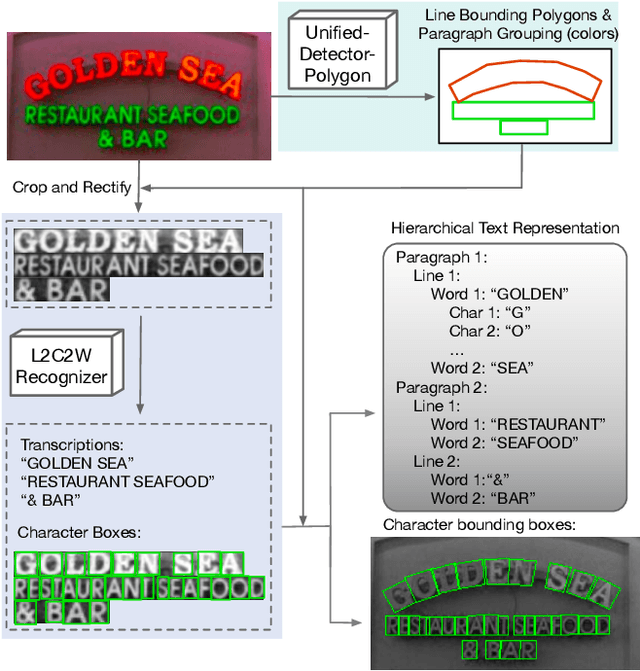

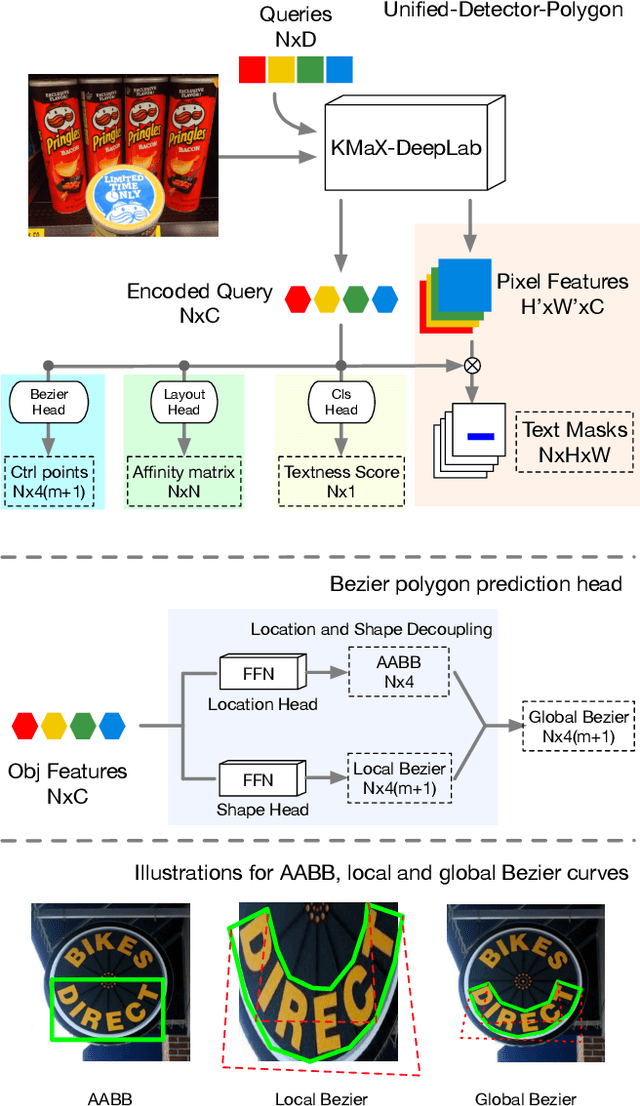
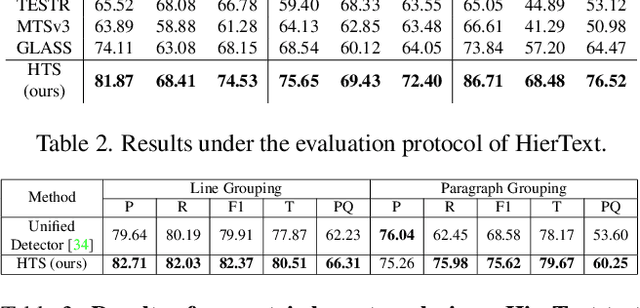
We propose Hierarchical Text Spotter (HTS), a novel method for the joint task of word-level text spotting and geometric layout analysis. HTS can recognize text in an image and identify its 4-level hierarchical structure: characters, words, lines, and paragraphs. The proposed HTS is characterized by two novel components: (1) a Unified-Detector-Polygon (UDP) that produces Bezier Curve polygons of text lines and an affinity matrix for paragraph grouping between detected lines; (2) a Line-to-Character-to-Word (L2C2W) recognizer that splits lines into characters and further merges them back into words. HTS achieves state-of-the-art results on multiple word-level text spotting benchmark datasets as well as geometric layout analysis tasks.
Efficient and Accurate Scene Text Detection with Low-Rank Approximation Network
Jun 27, 2023Recently, regression-based methods, which predict parameter curves for localizing texts, are popular in scene text detection. However, these methods struggle to balance concise structure and fast post-processing, and the existing parameter curves are still not ideal for modeling arbitrary-shaped texts, leading to a challenge in balancing speed and accuracy. To tackle these challenges, we firstly propose a dual matching scheme for positive samples, which accelerates inference speed through sparse matching scheme and accelerates model convergence through dense matching scheme. Then, we propose a novel text contour representation method based on low-rank approximation by exploiting the shape correlation between different text contours, which is complete, compact, simplicity and robustness. Based on these designs, we implement an efficient and accurate arbitrary-shaped text detector, named LRANet. Extensive experiments are conducted on three challenging datasets, which demonstrate the accuracy and efficiency of our LRANet over state-of-the-art methods. The code will be released soon.
PBFormer: Capturing Complex Scene Text Shape with Polynomial Band Transformer
Aug 29, 2023We present PBFormer, an efficient yet powerful scene text detector that unifies the transformer with a novel text shape representation Polynomial Band (PB). The representation has four polynomial curves to fit a text's top, bottom, left, and right sides, which can capture a text with a complex shape by varying polynomial coefficients. PB has appealing features compared with conventional representations: 1) It can model different curvatures with a fixed number of parameters, while polygon-points-based methods need to utilize a different number of points. 2) It can distinguish adjacent or overlapping texts as they have apparent different curve coefficients, while segmentation-based or points-based methods suffer from adhesive spatial positions. PBFormer combines the PB with the transformer, which can directly generate smooth text contours sampled from predicted curves without interpolation. A parameter-free cross-scale pixel attention (CPA) module is employed to highlight the feature map of a suitable scale while suppressing the other feature maps. The simple operation can help detect small-scale texts and is compatible with the one-stage DETR framework, where no postprocessing exists for NMS. Furthermore, PBFormer is trained with a shape-contained loss, which not only enforces the piecewise alignment between the ground truth and the predicted curves but also makes curves' positions and shapes consistent with each other. Without bells and whistles about text pre-training, our method is superior to the previous state-of-the-art text detectors on the arbitrary-shaped text datasets.
Flexible Keyword Spotting based on Homogeneous Audio-Text Embedding
Aug 12, 2023Spotting user-defined/flexible keywords represented in text frequently uses an expensive text encoder for joint analysis with an audio encoder in an embedding space, which can suffer from heterogeneous modality representation (i.e., large mismatch) and increased complexity. In this work, we propose a novel architecture to efficiently detect arbitrary keywords based on an audio-compliant text encoder which inherently has homogeneous representation with audio embedding, and it is also much smaller than a compatible text encoder. Our text encoder converts the text to phonemes using a grapheme-to-phoneme (G2P) model, and then to an embedding using representative phoneme vectors, extracted from the paired audio encoder on rich speech datasets. We further augment our method with confusable keyword generation to develop an audio-text embedding verifier with strong discriminative power. Experimental results show that our scheme outperforms the state-of-the-art results on Libriphrase hard dataset, increasing Area Under the ROC Curve (AUC) metric from 84.21% to 92.7% and reducing Equal-Error-Rate (EER) metric from 23.36% to 14.4%.
ICDAR 2023 Competition on Reading the Seal Title
Apr 24, 2023Reading seal title text is a challenging task due to the variable shapes of seals, curved text, background noise, and overlapped text. However, this important element is commonly found in official and financial scenarios, and has not received the attention it deserves in the field of OCR technology. To promote research in this area, we organized ICDAR 2023 competition on reading the seal title (ReST), which included two tasks: seal title text detection (Task 1) and end-to-end seal title recognition (Task 2). We constructed a dataset of 10,000 real seal data, covering the most common classes of seals, and labeled all seal title texts with text polygons and text contents. The competition opened on 30th December, 2022 and closed on 20th March, 2023. The competition attracted 53 participants from academia and industry including 28 submissions for Task 1 and 25 submissions for Task 2, which demonstrated significant interest in this challenging task. In this report, we present an overview of the competition, including the organization, challenges, and results. We describe the dataset and tasks, and summarize the submissions and evaluation results. The results show that significant progress has been made in the field of seal title text reading, and we hope that this competition will inspire further research and development in this important area of OCR technology.
Aggregated Text Transformer for Scene Text Detection
Nov 25, 2022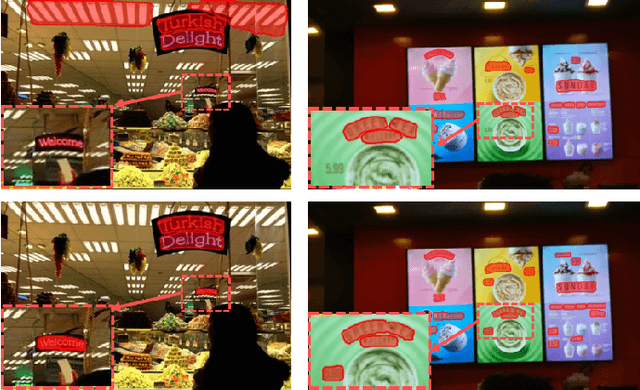
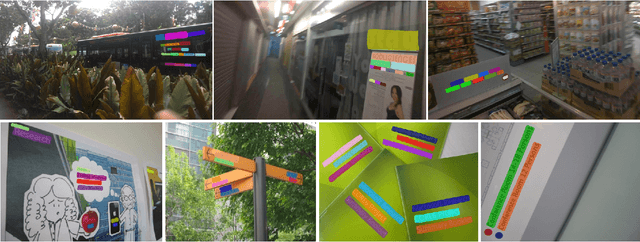
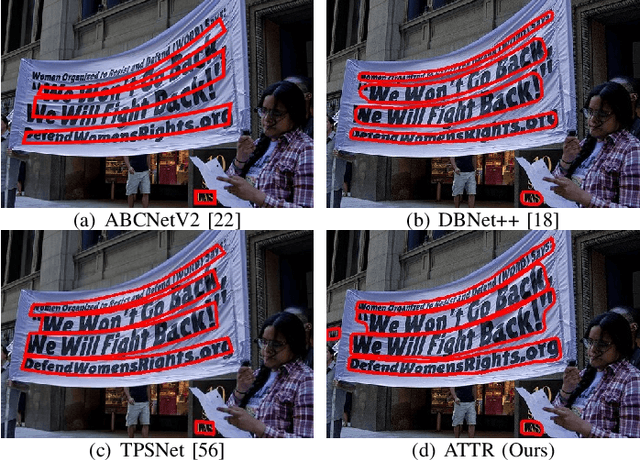

This paper explores the multi-scale aggregation strategy for scene text detection in natural images. We present the Aggregated Text TRansformer(ATTR), which is designed to represent texts in scene images with a multi-scale self-attention mechanism. Starting from the image pyramid with multiple resolutions, the features are first extracted at different scales with shared weight and then fed into an encoder-decoder architecture of Transformer. The multi-scale image representations are robust and contain rich information on text contents of various sizes. The text Transformer aggregates these features to learn the interaction across different scales and improve text representation. The proposed method detects scene texts by representing each text instance as an individual binary mask, which is tolerant of curve texts and regions with dense instances. Extensive experiments on public scene text detection datasets demonstrate the effectiveness of the proposed framework.
 Add to Chrome
Add to Chrome Add to Firefox
Add to Firefox Add to Edge
Add to Edge